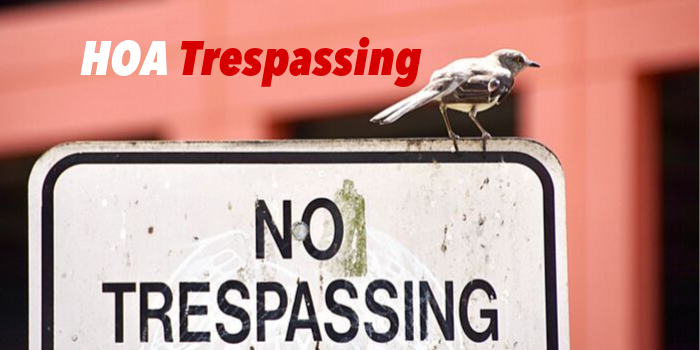Do members or representatives of the HOA have permission to enter into, or onto, a homeowner’s property? The short answer is, technically, yes. However, although there are times when, legally, the HOA can get authorization to enter a homeowner’s property, you may want to think twice before doing so! In many cases, the risks may outweigh the benefits.
What is Considered Trespassing and What Isn’t?
As a general rule, members of the HOA are allowed to enter another person’s property only in emergencies, to inspect for rule violations, or to perform maintenance or repairs on a common element. Usually, the HOA is required to give sufficient prior notice before entering the homeowner’s property. It should be noted that there is no provision in any declaration giving members of the HOA the authority to enter someone’s home, except in cases of emergency where it may be allowed. For example, if there is water leaking from one unit that is affecting another unit, or if someone notices smoke coming from inside a unit, the HOA entering the unit to solve the problem is, by and large, acceptable.
Always Check the CC&Rs First
The ‘authority’ for members of the HOA to enter another person’s property will be recorded in your community’s Declaration of Covenants, and your state may also have laws regarding when this is appropriate (if there is a discrepancy between state law and your community CC&Rs, the state law always trumps the community rule). Before taking any action, be sure that you locate specifically where it gives authority for you to go onto someone else’s property, and also where it gives your authority to take the action that you intend to take, because the two are not always tied together. For example, if the Declaration authorizes you to go onto someone’s property to maintain common elements (maybe you need to access an air duct, a heating element, or a pipe located within the wall), you do not necessarily have the authority to install or remove anything without the homeowner’s consent. Additionally, find out from your Declaration whether you have the right to recover the costs associated with your action. You may be authorized to correct a violation or do certain work on the property, but not authorized to collect money to cover the cost of the work.
Weigh the Risks and Benefits
Once you’ve deemed that your course of action is technically authorized via your Declaration of Covenants, you need to decide whether correcting the violation is worth the risk associated with entering onto someone’s property. There are several considerations to be had, including the physical safety of the HOA representative, the potential for angering residents, or being charged with trespass.
People will protect their home and their property. If you meet with an owner who is very protective of their property rights, you may be met with use of force by the homeowner and could find yourself in a dangerous situation. Additionally, there may be pets on the property who could pose a physical threat.
Police will generally not enforce the “self-help” provision of a declaration, and, if called, will likely ask you to leave unless you have an order issued by a court of law. The police will not allow you to trespass onto another person’s property, and if you persist, the HOA could be hit with a trespassing lawsuit.
There are also practical considerations associated with entering someone else’s property, such as:
- If you are there to correct a violation, once you complete the correction, will it have been worth your time? For example, if you are correcting a violation pertaining to landscaping, will your costly efforts be maintained once installed, or will it simply be a waste of time and money?
- Will you be able to complete the project entirely without entering the home? For example, the association would be unable to connect a sprinkler system without going inside to reach the connection point. In this situation, you would want to carefully decide whether correcting the violation is worth spending the association’s money without a chance of it being recouped.
- Are you being reasonable? If you hear a dog barking and the CC&R’s clearly say no dogs are to be allowed on the property, you have reasonable cause to investigate whether the rule is being violated. Giving advance notice in this situation would give the owner time to take the dog to a friend’s house for the day. However, do you want to enter a person’s property knowing that there is a dog inside and not knowing the temperament of that dog? Probably not!
- In another example, the HOA guidelines may state that homeowners cannot have sheds in their backyards. Is it reasonable for a member of the HOA to go into the backyard of every homeowner to inspect and see if a violation has been made? Though technically allowed, it is likely not practical.
Court Orders Can Cover Your Bases
If the violation is so severe that the association deems it necessary to enter onto another‘s property, it is highly recommended that a court order is obtained. Make sure that you have done everything in your power to solve the problem before it comes to this, taking all rule enforcement steps, such as giving appropriate notice, issuing fines, and providing a hearing if necessary. Fines are on your side in most situations. Fines can cause action that notices will not, saving you from taking legal action. However, when fines don’t work, it may be necessary to involve legal counsel. A letter that is sent by legal counsel demanding that the violation be corrected is often enough to spur homeowners to action. Since the letter is sent by an attorney, it will also provide sufficient documentation to a court that all necessary attempts were made to resolve the issue. If the violation goes uncorrected, the HOA can pursue litigation and receive a court order to be able to enter onto the property, correct the violation, and charge the owner for the associated costs.
Turning the Tables: Should Owners be Charged for Trespass by the HOA?
There are also situations where the HOA will find it necessary to charge a person in the community with trespass. Follow your rules enforcement protocol listed in your CC&Rs and escalate through those channels first. This process should not be taken lightly and should always involve taking prior steps to solve the problem without legal action and/or seeking legal counsel.
The HOA must first decide whether the problem is a violation of the rules or an actual trespass. Trespass should generally be reserved for people who are not residents of the community; otherwise, you risk alienating residents and causing splinters in the unity of your community. Technically, the amenities in the community belong, in part, to every homeowner in the community, so charging a part-owner with trespass is questionable.
For example, if homeowners are at the pool after hours, are they trespassing or are they violating rules? Fining the homeowner for a rule violation will likely work to solve this problem without the messy side effects of declaring a trespass. However, if it is a non-owner who is at the pool after hours, they are trespassing.
Other examples of trespass are when people are in violation of the association’s leasing rules, letting unapproved tenants live on the property, or are on the property after a foreclosure. In these situations, the HOA can file trespass against the violating party.
In all situations, proceed with caution! Make sure that all members of the board are doing their fiduciary duty and following all proper enforcement steps to solve problems before taking drastic measures. Avoid legal action whenever possible. Taking legal action will almost certainly cause discord throughout your community, so proceed only when absolutely necessary.
If your HOA board is faced with a difficult decision regarding your community, contact Spectrum AM today to speak with one of our experienced HOA property managers who can point you in the right direction and provide you with information you can trust.







